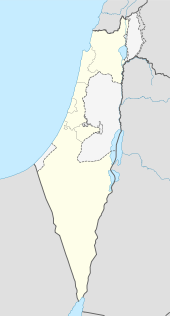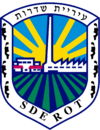Sderot
| Sderot | ||
|
||
| Hebrew | שְׂדֵרוֹת | |
| Arabic | سديروت | |
| Name meaning | Boulevards | |
| Founded in | 1953 | |
| Government | City (from 1996) | |
| District | South | |
| Coordinates | ||
| Population | 19,300 (2007) | |
| Jurisdiction | 4,472 dunams (4.472 km2/1.727 sq mi) | |
| Mayor | David Buskila | |
 Sderot
|
||
Sderot (Hebrew: שְׂדֵרוֹת) is a western Negev city in the Southern District of Israel. According to the Israel Central Bureau of Statistics (CBS), at the end of 2006 the city had a total population of 19,300.[1] The city has been an ongoing target of Qassam rocket attacks from the Gaza Strip. In March 2008, the mayor said the population had declined by 10%-15% as families left the city in desperation (aid organizations say the figure is closer to 25%). Many of the families that remain cannot afford to move out or are unable to sell their homes.[2]
Sderot, less than a mile from Gaza, has borne the brunt of Palestinian rocket attacks since 2001, killing 13 people, wounding dozens, causing millions of dollars in damage, and disrupting daily life and ruining the economy. From mid-June 2007 to mid-February 2008, 771 rockets and 857 mortar bombs have been fired at Sderot and the western Negev.[3]
Contents |
History
The first inhabitants of Sderot arrived in 1951 to what was then known as the Gevim-Dorot transit camp. Most of these residents were Kurdish and Persian refugees who lived in tents and shacks before building permanent structures almost four years later in 1954, with Sderot becoming the most easterly of the development towns in the northern Negev. In the 1961 census, the percentage of North African immigrants, mostly from Morocco, was 87% in the town, whilst another 11% of the residents were immigrants from Kurdistan.[4] In the 1950s, the city continued to absorb a large number of immigrants from Morocco and Romania, and was declared a local council in 1958.
Sderot again absorbed a large immigrant population during the Aliyah from the Soviet Union in the 1990s, and its population doubled in this decade. In 1996 it was declared a city.
Rocket fire from Gaza

Sderot lies one kilometer from the Gaza Strip and town of Beit Hanoun. Since the beginning of the Second Intifada in October 2000, the city has been under constant rocket fire from Qassam rockets launched by Hamas and Islamic Jihad.[5] Despite the imperfect aim of these homemade projectiles, they have caused deaths and injuries, as well as significant damage to homes and property, psychological distress and emigration from the city. The Israeli government has installed a "Red Dawn" (צבע אדום) alarm system to warn citizens of impending rocket attacks, although its effectiveness has been questioned. Citizens only have 15 seconds to reach shelter after the sounding of the alarm. Thousands of Qassam rockets have been launched since Israel's disengagement from the Gaza Strip in September 2005.
In May 2007, a significant increase in shelling from Gaza prompted the temporary evacuation of thousands of residents.[6] By November 23, 2007, 6,311 rockets had fallen on the city.[7] Yediot Ahronoth reported that during the summer of 2007, 3,000 of the city's 22,000 residents (comprised mostly of the city's key upper and middle class residents) left for other areas, out of Qassam rocket range. Arcadi Gaydamak has in recent years supported relief programs for residents who cannot leave.[8] On December 12, 2007, after more than 20 rockets landed in the Sderot area in a single day, including a direct hit to one of the main avenues, Sderot mayor Eli Moyal announced his resignation, citing the government's failure to halt the rocket attacks.[9] Moyal was persuaded to retract his resignation.
Demographics
According to CBS, in 2001 the ethnic makeup of the city was 99.8% Jewish, without significant Arab population. According to CBS, in 2001 there were 9,500 males and 9,700 females. The population of the city was spread out with 36.5% 19 years of age or younger, 16.2% between 20 and 29, 19.6% between 30 and 44, 14.3% from 45 to 59, 3.8% from 60 to 64, and 9.5% 65 years of age or older. The population growth rate in 2004 was 0.7%.
A number of Palestinian Arabs from the Gaza Strip were resettled in Sderot beginning in 1997 after cooperating with the Shin Bet.[10]
Income
According to CBS figures for 2000, there were 6,301 salaried workers and 367 self-employed in Sderot. The mean monthly wage was NIS 3,845, a real change of 9.0% over the course of 2000. Salaried males had a mean monthly wage of NIS 4,911 (a real change of 11.3%) versus NIS 2,665 for females (a real change of 2.4%). The mean income for the self-employed was NIS 5,378. 603 citizens received unemployment benefits and 3,183 received income supplements.
Education
According to CBS, there are 14 schools and 3,578 students in the city. They are spread out as eleven elementary schools and 2,099 elementary school students, and six high schools and 1,479 high school students. 56.5% of 12th grade students were entitled to a matriculation certificate in 2001. Sapir Academic College and the Hesder Yeshiva of Sderot are located in Sderot.
Commemoration
In a gesture of solidarity, El Al (Israel's national airline) named one of its first two Boeing 777 passenger planes "Sderot" (the other was named for Kiryat Shmona).[11] Documentary filmmaker Laura Bialis, currently living in Sderot, is making a film that focuses on young musicians living under the daily threat of Qassams.[12][13][14]
Notable residents
- Amir Peretz, former defense minister
- Kobi Oz, lead singer of Teapacks
- Miri Bohadana, model
See also
- List of Qassam rocket attacks
External links
- Sderot Media Center
- sderot portal-hebrew
- Sderot Information Center for the Western Negev
- The committee for a secure Sderot
- YouTube Video about Sderot
- Sderot in The Washington Post
References
- ↑ "Table 3 - Population of Localities Numbering Above 1,000 Residents and Other Rural Population". Israel Central Bureau of Statistics (2008-06-30). Retrieved on 2008-10-18.
- ↑ Hadad, Shmulik (2008-03-19). "Sderot: Those Who Can Afford It Have Already Left", Ynetnews. Retrieved on 2008-10-20.
- ↑ "Qassam Rockets - Background and Statistics". Zionism-Israel.com. Retrieved on 2008-10-20.
- ↑ Rapoport, Meron (2007-05-25). "The Pioneers of Sderot". Haaretz. Retrieved on 2008-10-20.
- ↑ Silverman, Anav (2007-09-20). "A City Under Siege: An Inside View of Sderot, Israel". Sderot Media Center. Retrieved on 2008-10-20.
- ↑ Kershner, Isabel (2007-05-31). "Israeli Border Town Lives in the Shadow of Falling Rockets". International Herald Tribune. Retrieved on 2008-10-20.
- ↑ Sackett, Shmuel (2007-12-07). "23 Years and 6,311 Rockets". Israel Insider. Retrieved on 2008-10-20.
- ↑ "3,000 Sderot Residents Have Left Town", The Jerusalem Post (2007-11-16). Retrieved on 2008-10-20.
- ↑ "Israeli Mayor Quits Over Rockets", BBC Online (2007-12-12). Retrieved on 2008-10-20.
- ↑ Hadad, Shmulik (2007-05-30). "Palestinian Collaborator: Terrorists Only Understand Force". Ynetnews. Retrieved on 2008-10-20.
- ↑ Boeing 777 Named for Sderot, infolive.tv, 2007-07-31, http://www.infolive.tv/en/infolive.tv-10224-israelnews-el-als-ace-hat-boeing-777, retrieved on 2008-10-20
- ↑ Zaitchik, Alexander (2008-03-16). "Documentary Pulls Back Iron Curtain". The Forward. Retrieved on 2008-10-20.
- ↑ Fuma, Simona (2008-04-23). "Rebel With a Cause". World Jewish Digest. Retrieved on 2008-10-20.
- ↑ Lash Balint, Judy (2008-03-02). "Only Thirty-Six Hours in Sderot". San Diego Jewish World. Retrieved on 2008-10-20.
|
|||||||||||||
